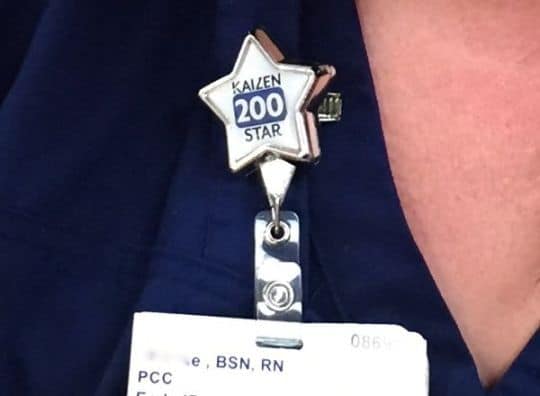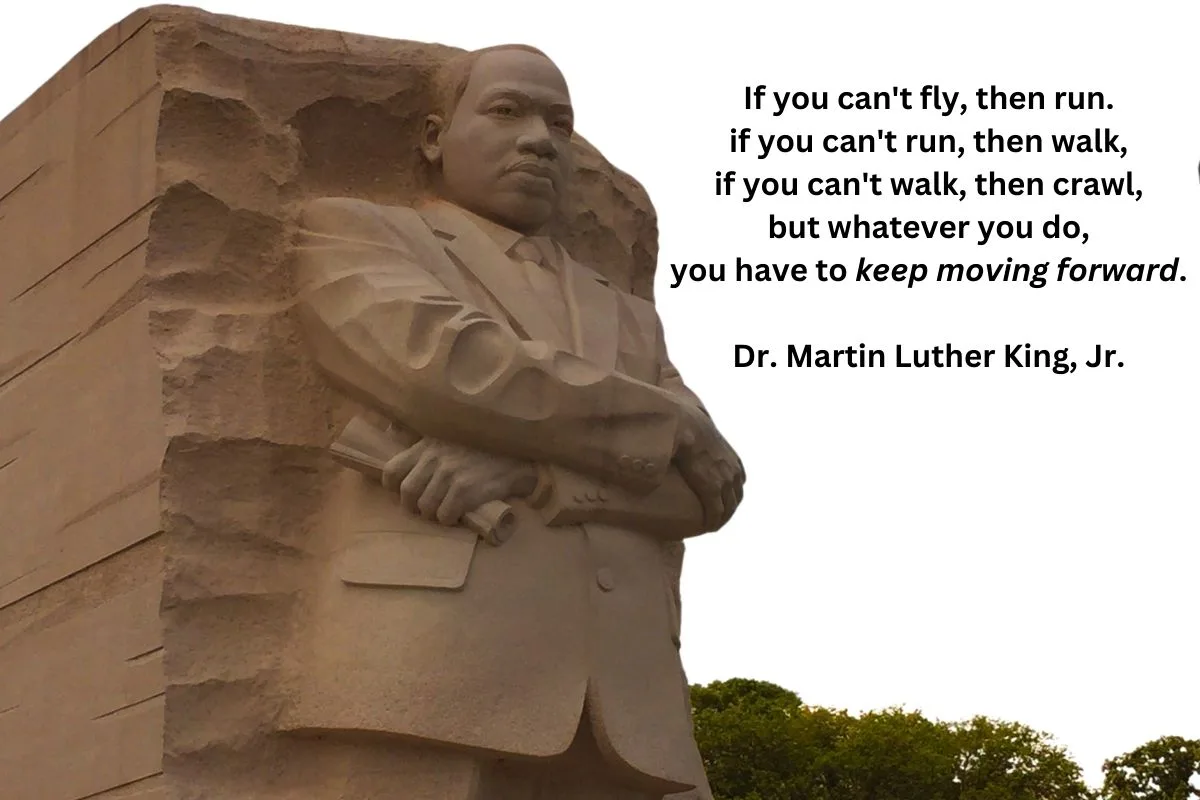Last week, I had the opportunity to spend a day with my Healthcare Kaizen co-author Joe Swartz and his colleagues at one of the three hospitals in the Franciscan St. Francis Health system. It was my second visit and, like the first, it reinforced my view that a culture of continuous improvement really is possible – and when you see it, it's a wonderful thing. It's even better to work in it.
The people of Franciscan have implemented and documented more than 20,000 Kaizen improvements over the past seven years. In most recent years, they have had between employee participation rates in the mid 30% to mid 40% ranges. Those are participation rates that most organizations would love to have, along with the measurable benefits – more than $5 million in hard cost savings, along with improvements to patient satisfaction, quality, and employee engagement.
Staff get to wear a special badge holder when they hit milestones about how many Kaizens they have implemented — 200 for one nurse! She's a “Kaizen Star!”

I was asked to give a presentation about how to engage everybody in continuous improvement – a noble and important goal. They might be the only hospital to be visited by both Norman Bodek and Masaaki Imai, two men who have done as much as anybody to spread Kaizen. I humbly follow in their footsteps. In my talk, I shared some stories from other organizations that have gotten started with Kaizen, including other hospitals and Catholic Charities Fort Worth (where I've done some pro-bono work).
Rather than trying to stand on a stage to tell Franciscan what to do, I tried to draw out ideas from leaders in the audience. There are some departments where virtually everybody IS participating in Kaizen. “What are those leaders doing?,” I asked. “How can we use Kaizen principles to improve how we do Kaizen?”
I proposed that the answers were already in the room and just needed to shared and emulated more broadly. In the Kaizen approach, improvements are not just tested and implemented – they are documented and shared (through a home-grown web database they've created, along with other more analog methods).
Those leadership practices and leader behaviors from the departments with near 100% participation can be shared with other leaders. Franciscan already tries to encourage friendly competition, within teams and between departments by posting data about participation levels. The easiest thing to measure is the number of Kaizens and the percentage of people participating. The impact of those Kaizens also matters too, as leaders try to keep their employees connected to the mission and purpose of their work.
We brainstormed ways that leaders can share ideas about how to improve how they improve. They had many ideas and, in the spirit of Kaizen, I shared an idea from one of my clients who is planning to have occasional internal “Kaizen Conferences” to compare notes on what is working best throughout the health system to encourage Kaizen.
The answers are often right around us if we humbly inquire and compare notes. I admire Franciscan leaders for not blaming employees who don't participate in Kaizen. They are challenging themselves to create environments where people want to do Kaizen. The leaders set the tone for their employees.
One department we visited was endoscopy. Joe and I interviewed leaders and a number of nurses. The teamwork was apparent, as the nurses wanted to talk to us in groups because most of their Kaizen work is done in small groups. There is a letter “i” in the word Kaizen, but it's really more of a “we” thing than an “I thing.” They find joy in their improvement work, mainly for the intrinsic rewards that it brings (and the tangible benefits to their patients). A team of 30 people has implemented over 750 improvements so far this year, making them one of the highest-performing departments in the system.
The one word that got used a lot by staff and leaders was that they felt “unleashed” to use their creativity, to take action, and to do the right things for their patients and their co-workers. The imagery of that word “unleashed” makes one pause and think about organizations that figuratively “leash” their employees, as if to keep them from running off and doing things. Are we trying to get employees to behave or do we want them to improve and innovate?
At Franciscan, and in my visits to other hospitals, I've found the bottleneck in the improvement process is hardly ever a lack of employee ideas. People working in healthcare care deeply about their work and their patients. They are smart and creative. They can do great things, through the practice of Kaizen – identify and solving dozens or hundreds of improvements in their department.
What holds back improvement and innovation? It's the organization's culture and the behavior of managers and senior leaders. Most organizations say they want a “culture of continuous improvement” (just check the websites of health systems).
If you ever find yourself complaining that you team doesn't have a culture of continuous improvement, don't blame the employees – look in the mirror and think about what you're doing (or not doing) as a manager. If you're a senior leader, look in the mirror and reflect upon what behaviors of yours stifle Kaizen and which behaviors encourage and support Kaizen. It starts with you.
I'll be writing more posts about the visit to Franciscan – it really is inspiring.
What do you think? Please scroll down (or click) to post a comment. Or please share the post with your thoughts on LinkedIn – and follow me or connect with me there.
Did you like this post? Make sure you don't miss a post or podcast — Subscribe to get notified about posts via email daily or weekly.
Check out my latest book, The Mistakes That Make Us: Cultivating a Culture of Learning and Innovation:










Great stuff, Mark. This is a terrific example of what’s possible.
Hey Mark,
How did they find the time for employees to participate in all these Kaizens? Is it built into their budget or have they found more time to do Kaizen from their previously implemented Kaizens?
Hi Ryan E,
In order to help departments get started with Kaizen we do have a budget set aside and staff can bill their Kaizen time to my department. We try to wean them off in 6 months. Typically Kaizen does free up time for staff to Kaizen more.
– Joe
Wonderful. Thank you for the f/u. Trying to sell that idea to our exec team as we try to implement Lean. Hard to hold Kaizen and bring the stakeholders in when you have no budget for it.
One key lesson with Kaizen… if you don’t have time for Kaizen, don’t think about big formal Kaizen Events (aka Rapid Improvement Events).
Think small improvements that really don’t take much time. Get the ball rolling. Solicit and help implement small ideas. Free up time for other Kaizen improvements.
Ask “what can I do to create time for Kaizen?” Be creative. You don’t need a budget for it.
Hi Ryan
Here I agree with Mark it is often better to start with small quick little kaizens than to try an event. The few minutes per day it takes to try small things in the beginning will often free up more than enough time to start to tackle bigger and bigger issues. In fact I only recommend using events to tackle problems with a quick large benefit attached. Thus the money for the event comes from two possible places the savings it generates or the increase in value you produce from having done it.
Anything else can be done in a serious of small steps that take little time. But as people get better at it you will always find that the speed with which they do things increases. After all they see and believe in the benefits they are creating.
Joseph,
That sounds like a great way to get the ball rolling and to allow departments to benefit from their time savings after they’ve created them. What happens in the event that the time isn’t freed up or when a manager still wants to use those funds after 6 months?
I can’t answer for Joe, but what I’ve seen is that time WILL be freed up. Once employees get a taste for Kaizen, they won’t want to stop improving and you won’t want to stop them or worry about budgets, approval, etc. They will make it happen.
I love how the staff sounds so energized and passionate about kaizen. It’s clear they’re owning it (and that they’ve been enabled to own it).
Just wait until you see the videos we are going to publish. You will see and hear that enthusiasm, pride, and joy.